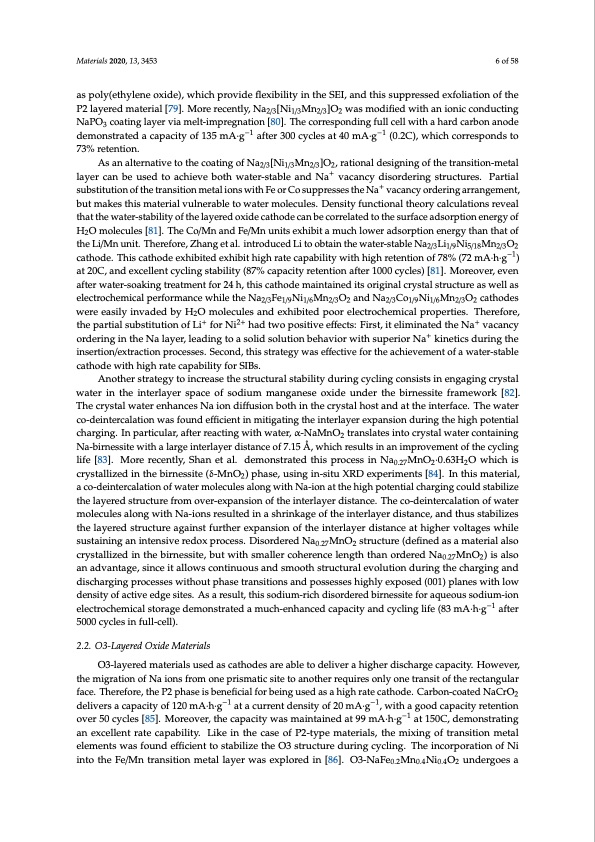
PDF Publication Title:
Text from PDF Page: 006
Materials 2020, 13, 3453 6 of 58 as poly(ethylene oxide), which provide flexibility in the SEI, and this suppressed exfoliation of the P2 layered material [79]. More recently, Na2/3[Ni1/3Mn2/3]O2 was modified with an ionic conducting NaPO3 coating layer via melt-impregnation [80]. The corresponding full cell with a hard carbon anode demonstrated a capacity of 135 mA·g−1 after 300 cycles at 40 mA·g−1 (0.2C), which corresponds to 73% retention. As an alternative to the coating of Na2/3[Ni1/3Mn2/3]O2, rational designing of the transition-metal layer can be used to achieve both water-stable and Na+ vacancy disordering structures. Partial substitution of the transition metal ions with Fe or Co suppresses the Na+ vacancy ordering arrangement, but makes this material vulnerable to water molecules. Density functional theory calculations reveal that the water-stability of the layered oxide cathode can be correlated to the surface adsorption energy of H2O molecules [81]. The Co/Mn and Fe/Mn units exhibit a much lower adsorption energy than that of the Li/Mn unit. Therefore, Zhang et al. introduced Li to obtain the water-stable Na2/3Li1/9Ni5/18Mn2/3O2 cathode. This cathode exhibited exhibit high rate capability with high retention of 78% (72 mA·h·g−1) at 20C, and excellent cycling stability (87% capacity retention after 1000 cycles) [81]. Moreover, even after water-soaking treatment for 24 h, this cathode maintained its original crystal structure as well as electrochemical performance while the Na2/3Fe1/9Ni1/6Mn2/3O2 and Na2/3Co1/9Ni1/6Mn2/3O2 cathodes were easily invaded by H2O molecules and exhibited poor electrochemical properties. Therefore, the partial substitution of Li+ for Ni2+ had two positive effects: First, it eliminated the Na+ vacancy ordering in the Na layer, leading to a solid solution behavior with superior Na+ kinetics during the insertion/extraction processes. Second, this strategy was effective for the achievement of a water-stable cathode with high rate capability for SIBs. Another strategy to increase the structural stability during cycling consists in engaging crystal water in the interlayer space of sodium manganese oxide under the birnessite framework [82]. The crystal water enhances Na ion diffusion both in the crystal host and at the interface. The water co-deintercalation was found efficient in mitigating the interlayer expansion during the high potential charging. In particular, after reacting with water, α-NaMnO2 translates into crystal water containing Na-birnessite with a large interlayer distance of 7.15 Å, which results in an improvement of the cycling life [83]. More recently, Shan et al. demonstrated this process in Na0.27MnO2·0.63H2O which is crystallized in the birnessite (δ-MnO2) phase, using in-situ XRD experiments [84]. In this material, a co-deintercalation of water molecules along with Na-ion at the high potential charging could stabilize the layered structure from over-expansion of the interlayer distance. The co-deintercalation of water molecules along with Na-ions resulted in a shrinkage of the interlayer distance, and thus stabilizes the layered structure against further expansion of the interlayer distance at higher voltages while sustaining an intensive redox process. Disordered Na0.27MnO2 structure (defined as a material also crystallized in the birnessite, but with smaller coherence length than ordered Na0.27MnO2) is also an advantage, since it allows continuous and smooth structural evolution during the charging and discharging processes without phase transitions and possesses highly exposed (001) planes with low density of active edge sites. As a result, this sodium-rich disordered birnessite for aqueous sodium-ion electrochemical storage demonstrated a much-enhanced capacity and cycling life (83 mA·h·g−1 after 5000 cycles in full-cell). 2.2. O3-Layered Oxide Materials O3-layered materials used as cathodes are able to deliver a higher discharge capacity. However, the migration of Na ions from one prismatic site to another requires only one transit of the rectangular face. Therefore, the P2 phase is beneficial for being used as a high rate cathode. Carbon-coated NaCrO2 delivers a capacity of 120 mA·h·g−1 at a current density of 20 mA·g−1, with a good capacity retention over 50 cycles [85]. Moreover, the capacity was maintained at 99 mA·h·g−1 at 150C, demonstrating an excellent rate capability. Like in the case of P2-type materials, the mixing of transition metal elements was found efficient to stabilize the O3 structure during cycling. The incorporation of Ni into the Fe/Mn transition metal layer was explored in [86]. O3-NaFe0.2Mn0.4Ni0.4O2 undergoes aPDF Image | Electrode Materials for Sodium-Ion Batteries

PDF Search Title:
Electrode Materials for Sodium-Ion BatteriesOriginal File Name Searched:
materials-13-03453-v2.pdfDIY PDF Search: Google It | Yahoo | Bing
Salgenx Redox Flow Battery Technology: Salt water flow battery technology with low cost and great energy density that can be used for power storage and thermal storage. Let us de-risk your production using our license. Our aqueous flow battery is less cost than Tesla Megapack and available faster. Redox flow battery. No membrane needed like with Vanadium, or Bromine. Salgenx flow battery
| CONTACT TEL: 608-238-6001 Email: greg@salgenx.com | RSS | AMP |